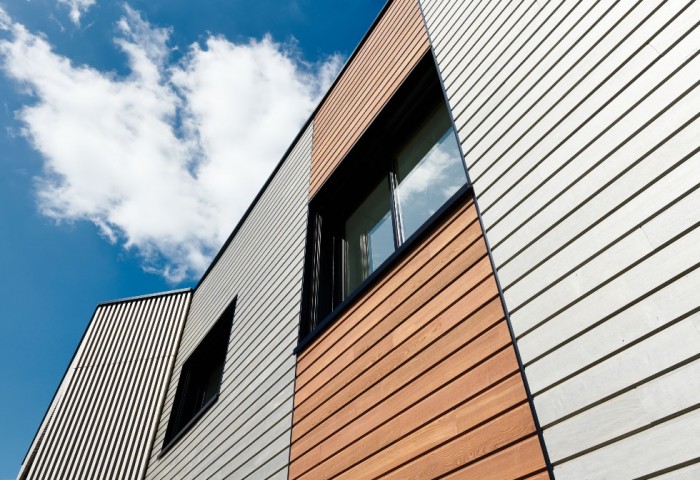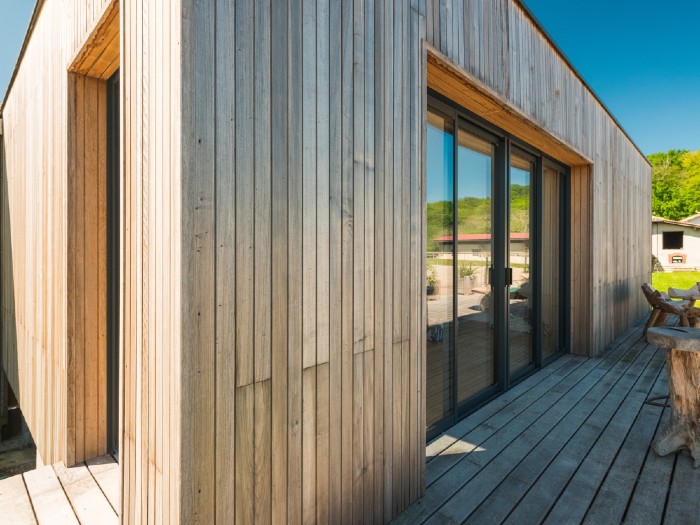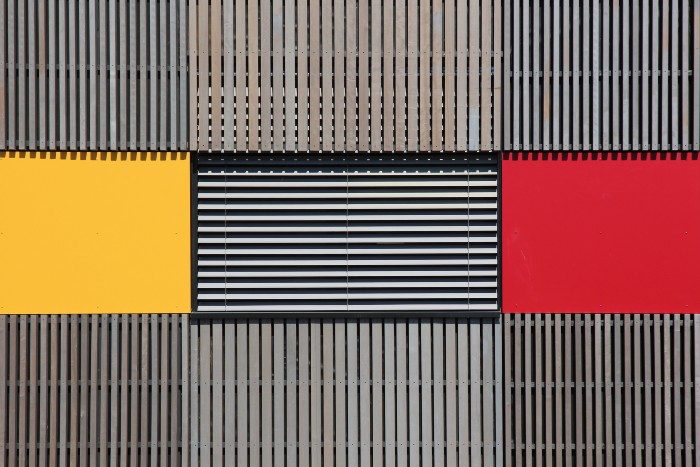A successful wood cladding project

Just like interior design, exterior design is an essential element in bringing harmony to a project as a whole. Wood cladding can be an excellent way of bringing modernity and originality to your projects, while meeting eco-design requirements.
Wooden cladding is an attractive and insulating way to dress a building. Pleasant to the touch and to the eye, why not give meaning to your projects by using natural wood products made in France?
Wood, which has been used since time immemorial, remains an ideal material for outdoor applications, offering lasting resistance to the elements. Some wood species have a natural durability that protects them from biological attack such as fungi and insects. For species that are more sensitive to outdoor conditions, there are durable, natural preservative treatments such as Thermo wood. Wood that is sufficiently resistant may not require any maintenance, unless you want to prevent greying. It's a good idea to anticipate natural aesthetic changes so that you can make informed decisions in advance and determine the frequency of maintenance, if necessary.
Thoughtful design is also crucial to ensuring uniform and satisfactory development: the orientation of the cladding, the projection of the roof, the choice of profiles, etc., are all considerations to be taken into account before work begins. Compliance with construction standards is essential to guarantee the durability of the structure.
At Ducerf, we offer a range of natural hardwood cladding and cladding treated by high temperature (THT), for all projects, offices, individual or collective housing, public projects...
Wood cladding, for greener construction
Wood is a very environmentally-friendly material for cladding the exterior of a building, and is one of the most advantageous solutions because of the minimal impact it has on the environment. Installing wooden cladding helps to meet environmental challenges by choosing a local resource. The cladding boards in our Coté Parc range are a good alternative to imported wood.
What's more, it's a material that comes from a local, renewable resource that will store carbon throughout its lifespan, another argument for including this type of solution in your projects.
How can a timber façade project be a success?
When designing a building, the choice of façade cladding is of particular importance. Although it provides protection and resistance to impact, the façade material will above all have an impact on the aesthetics of the building and give it an identity throughout its life. The choice of façade cladding must take into account the expectations of the client and users (tastes, ability to maintain, budget) and the evolution of the façade material over time (appearance on delivery and 5, 10, 15 years later).
These expectations must be clearly formulated from the outset of the project, as they will enable the most appropriate material or materials to be proposed.
Choice of wood species
The choice of wood species is very important, depending on the needs of the project. Care should be taken to select species that are suitable for outdoor use, taking into account aspects such as durability, weather resistance and aesthetic appeal.
- THT poplar cladding
THT poplar wood cladding is light and durable. A fast-growing local species, poplar is also known for its lightness.
From an aesthetic point of view, THT poplar cladding offers a warm, contemporary chocolate colour that will evolve towards a natural patina in very even shades of grey.
- THT ash cladding
Ash cladding is a darker species than poplar, offering a beige-brown colour with very pronounced veining that catches the light very well, and will develop a natural patina in very even shades of grey.
Choosing the layout and laying direction for the boards
When cladding boards are laid vertically, they give the building an impression of height. This direction of installation is also a good way of draining off rainwater.
Laying cladding horizontally on a facade is a common method. Corner cuts should be protected to prevent rainwater infiltration.
You can also mix and match several widths cladding profiles to give the façade a distinctive look.
Wood cladding offers a host of aesthetic possibilities!
Finishes and maintenance
Wood is a living material that evolves and develops a patina over time. Whatever the species, the natural resin contained in wood fades over time and takes on a grey tinge, more commonly known as wood greying. This is caused by UV rays and exposure to the elements, particularly humidity.
This in no way alters the quality or durability of the wood, but gives it a silvery-grey appearance.
There are 3 solutions for your projects.
- Let the wood evolve naturally to its grey colour
- Choose pre-greyed cladding
- Preserve the original appearance or colour the wood
With thermo-treated wood products, an even shade of grey will appear naturally after about a year.
There are various finishes, including ecological saturators, to maintain, protect or revive exterior thermo-wood. For a facade that turns grey immediately, anticipating the natural patina, you can choose pre-greased cladding. To maintain the wood's original colour or to add colour, there are ecological solutions such as saturators.
Finally, to prolong the life of your wood cladding, you should follow good maintenance practices.










